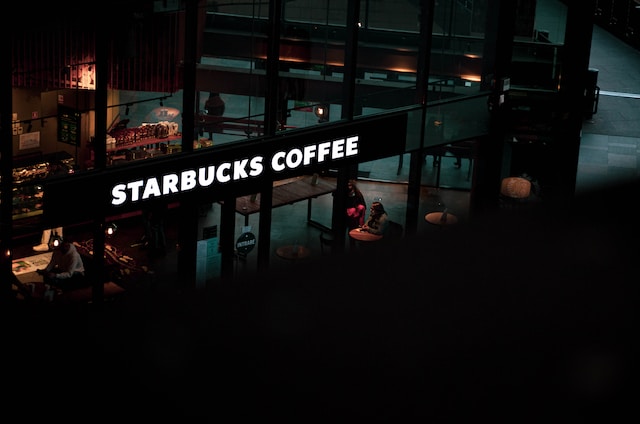Before we dive deep into the PESTEL analysis, let’s get the business overview of Starbucks. Starbucks Corporation, founded in Seattle, Washington, in 1971, has grown to become the world’s largest coffeehouse chain and one of the most recognizable brands in the specialty coffee industry. Known for its iconic green mermaid logo, Starbucks has expanded its presence globally, with more than 35,700+ stores in over 80 countries as of 2022.
Business Model: Starbucks operates under a retail and franchise model, with most company-operated stores (51%). The company primarily generates revenue by selling premium coffee and other beverages, including espresso-based drinks, teas, and smoothies. Additionally, Starbucks offers a variety of food items such as sandwiches, salads, pastries, and snacks. The company also sells coffee beans, ground coffee, and single-serve products for at-home consumption.
Starbucks strongly focuses on providing a consistent and comfortable in-store experience, emphasizing customer service and an inviting atmosphere. Many stores offer free Wi-Fi and ample seating to encourage customers to spend time in the stores. The company has also developed a successful loyalty program called Starbucks Rewards, which offers exclusive deals and promotions to members.
Diversification and Expansion: Over the years, Starbucks has diversified its product offerings by launching new lines of beverages, such as the Teavana range of teas, and acquiring other companies, including Evolution Fresh (a cold-pressed juice company) and La Boulange (a bakery chain). The company has also entered the ready-to-drink (RTD) market through partnerships with PepsiCo and Anheuser-Busch InBev.
Furthermore, Starbucks has expanded its operations beyond physical stores by introducing various digital initiatives, such as mobile ordering and payment through the Starbucks app. This has enabled the company to reach new customers and streamline the in-store experience.
- Global comparable store sales increased 8%, driven by a 5% increase in average ticket and 3% increase in comparable transactions North America and U.S. comparable store sales increased 9%, driven by a 6% increase in average ticket and 3% increase in comparable transactions
- International comparable store sales increased 5%, driven by a 5% increase in comparable transactions; China comparable store sales increased 2%, driven by a 4% increase in comparable transactions and 2% decline in average ticket
- Consolidated net revenues up 12%, to a record $36.0 billion, or 14%, excluding a 2% unfavorable impact from foreign currency translation
Starbucks business model & supply chain analysis
Here is the PESTEL analysis of Starbucks
A PESTEL analysis is a strategic management framework used to examine the external macro-environmental factors that can impact an organization or industry. The acronym PESTEL stands for:
- Political factors: Relate to government policies, regulations, political stability, and other political forces that may impact the business environment.
- Economic factors: Deal with economic conditions and trends affecting an organization’s operations, profitability, and growth.
- Sociocultural factors: Relate to social and cultural aspects that may influence consumer preferences, lifestyles, demographics, and market trends.
- Technological factors: Deal with developing and applying new technologies, innovations, and trends that can impact an industry or organization.
- Environmental factors: Relate to ecological and environmental concerns that may affect an organization’s operations and decision-making.
- Legal factors: Refer to the laws and regulations that govern businesses and industries.
In this article, we will do a PESTEL Analysis of Starbucks.
PESTEL Analysis Framework: Explained with Examples
Political
- Political stability: The political stability of the countries in which Starbucks operates is a crucial factor. Stable political environments ensure a favorable business climate, while political unrest can lead to disruptions in supply chains, increased costs, and potential loss of business.
- Trade policies: Starbucks relies on importing coffee beans from various countries. Changes in trade policies, such as tariffs, quotas, and regulations, can affect the price and availability of coffee beans, impacting the company’s costs and profitability.
- Tax policies: Starbucks operates in multiple countries, each with its own tax policies and rates. Changes in corporate tax rates, sales tax, or other taxes can directly impact Starbucks’ profitability.
- Employment laws: As a global employer, Starbucks must comply with labor laws and regulations in each country it operates. This includes minimum wage, working hours, and workers’ rights. These laws can impact labor costs, employee relations, and overall operations.
- Health and safety regulations: Starbucks must adhere to each country’s food safety and hygiene standards. This includes regulations on ingredient sourcing, storage, and preparation. Compliance with these regulations is essential to maintain customer trust and brand reputation.
- Political lobbying and advocacy: Starbucks engages in political lobbying and advocacy to shape regulations and policies that impact its business. This includes advocating for fair trade, sustainable farming practices, and other corporate social responsibility (CSR) initiatives.
- International relations: Starbucks’ operations can be affected by international relations, such as diplomatic ties between countries, geopolitical tensions, or trade wars. This can impact the company’s supply chain, access to new markets, and overall growth.
Economic
- Economic growth: The level of economic growth in the countries where Starbucks operates directly impacts the company’s sales and revenue. Higher economic growth increases consumer spending, increasing demand for Starbucks’ products.
- Inflation and interest rates: Inflation and interest rates influence Starbucks’s overall operations costs. High inflation rates can lead to increased prices for raw materials, labor, and other operational costs. Additionally, higher interest rates can affect Starbucks’ borrowing costs and capital expenditures.
- Exchange rates: As a global company, Starbucks is exposed to fluctuations in foreign exchange rates. Changes in exchange rates can affect the cost of importing coffee beans and other raw materials, as well as the revenue generated from international sales.
- Unemployment rate: The unemployment rate in the countries where Starbucks operates can impact its labor costs and consumer demand for its products. High unemployment rates may result in lower labor costs but can also lead to decreased consumer spending.
- Disposable income: Consumer disposable income directly influences the demand for Starbucks’ products. Consumers with more disposable income are more likely to spend on non-essential items like specialty coffee beverages. Conversely, consumers may cut back on discretionary spending during economic downturns, negatively impacting Starbucks’ sales.
- Consumer confidence: The level of consumer confidence in the economy influences spending patterns. When consumer confidence is high, people are more likely to spend on non-essential items, such as coffee from Starbucks. Low consumer confidence can lead to reduced spending and lower sales for the company.
- Competitiveness of the market: The overall competitiveness of the coffee industry can impact Starbucks’ pricing strategies, product offerings, and broad market share. Economic factors like new market entrants or price wars among competitors can influence Starbucks’ performance.
Sociocultural
- Consumer preferences and lifestyle trends: Starbucks must be aware of changing consumer preferences, such as preferences for healthier food and beverage options, plant-based alternatives, or sustainable packaging. Adapting to these trends can help Starbucks stay relevant and competitive.
- Demographics: Population demographics, such as age, gender, and income levels, can influence the demand for Starbucks’ products. For instance, younger populations may be more attracted to innovative beverage options, while higher-income consumers may be more willing to spend on premium products.
- Cultural diversity: Starbucks operates in numerous countries, each with its own unique culture and traditions. Understanding and adapting to local tastes and preferences is essential for the company to be successful in these diverse markets. This may involve offering region-specific products, customizing store designs, or adopting culturally appropriate marketing strategies.
- Health consciousness: Consumers’ increasing focus on health and wellness can impact Starbucks’ product offerings. To cater to this trend, the company may need to develop healthier beverage and food options, such as low-calorie drinks, sugar-free alternatives, or organic ingredients.
- Ethical consumption: Consumers are becoming more conscious of their purchasing decisions’ ethical and environmental implications. As a result, Starbucks must address concerns related to fair trade, sustainable sourcing, and corporate social responsibility (CSR) initiatives to maintain its brand reputation and attract ethically-minded customers.
- Work culture: The evolving work culture, such as remote work and flexible work arrangements, can affect how people consume Starbucks’ products. For instance, the company may need to adapt its store layouts or digital offerings to cater to a growing number of remote workers seeking a comfortable workspace.
- Social media influence: The pervasive influence of social media on consumer behavior can impact Starbucks’ marketing strategies and brand perception. The company must leverage social media platforms to engage with customers, promote new products, and handle potential negative publicity.
- Starbucks SWOT Analysis
- Starbucks Marketing Mix (4Ps)
- Starbucks prices products on value, not cost. Why?
Technological
- Mobile technology: The widespread use of smartphones has influenced how customers interact with businesses. Starbucks has embraced mobile technology with its Starbucks App, which allows customers to place orders, make payments, and earn rewards. Continual investment in mobile technology can help Starbucks enhance customer engagement and streamline the in-store experience.
- E-commerce and delivery platforms: The growth of e-commerce and on-demand delivery platforms has changed consumer expectations for convenience and speed. Starbucks can leverage these platforms to expand its reach and cater to customers who prefer ordering online or using delivery services.
- Automation and robotics: Advances in automation and robotics can impact Starbucks’ operations, such as automated coffee machines, self-service kiosks, or robotic baristas. These technologies can improve efficiency, reduce labor costs, and enhance customer experience.
- Internet of Things (IoT) and data analytics: IoT and data analytics can provide valuable insights into customer preferences and behavior, enabling Starbucks to optimize its product offerings, store operations, and marketing strategies. Furthermore, IoT devices can help the company monitor and manage its supply chain and inventory more effectively.
- Social media platforms and digital marketing: Social media and digital marketing tools offer new ways for Starbucks to engage with customers, promote its products, and maintain its brand presence. Staying current with digital marketing trends and technologies can help Starbucks maintain a strong online presence and reach new customers.
- Sustainability technologies: As environmental concerns become more prevalent, Starbucks can adopt innovative technologies to minimize its environmental footprint. This may involve implementing energy-efficient equipment, renewable energy sources, or waste reduction technologies in its stores and supply chain.
- Cybersecurity: As Starbucks increasingly relies on digital technology, it becomes more vulnerable to cyber threats. Investing in robust cybersecurity measures is essential to protect customer data, financial information, and the company’s reputation.
Environmental
- Climate change: Climate change can have a significant impact on the global coffee industry, as coffee beans are sensitive to temperature, rainfall, and other climatic conditions. Changes in weather patterns can affect coffee crop yields, quality, and the overall supply chain, leading to potential disruptions and increased costs for Starbucks.
- Water usage and conservation: Coffee production, especially in water-intensive processing methods, can strain water resources in coffee-growing regions. Starbucks must be mindful of its water usage and invest in water conservation measures throughout its supply chain to minimize its environmental impact.
- Waste management and recycling: Starbucks produces a considerable amount of waste, particularly from single-use packagings like cups, lids, and straws. The company needs to focus on waste reduction initiatives, such as promoting reusable cups, adopting sustainable packaging materials, and supporting recycling programs.
- Energy efficiency: Starbucks can reduce its environmental footprint by implementing energy-efficient technologies and practices in its stores, such as lighting, heating, and cooling systems. The company can also invest in renewable energy sources to minimize greenhouse gas emissions.
- Sustainable sourcing: Starbucks has committed to the sustainable and ethical sourcing of its coffee beans through initiatives like the Coffee and Farmer Equity (CAFE.) Practices program. Ensuring coffee is sourced from environmentally responsible and socially equitable suppliers can help the company maintain its brand image and meet increasing consumer demand for ethically produced products.
- Biodiversity and habitat conservation: Coffee farming can contribute to deforestation and habitat loss if not managed sustainably. Starbucks should continue to support sustainable farming practices that promote biodiversity and habitat conservation in coffee-growing regions.
- Regulatory compliance: Starbucks must comply with environmental regulations in its operating countries. This may involve adhering to laws related to waste disposal, emissions, or conservation efforts. Compliance with these regulations is crucial for avoiding fines, penalties, and reputational damage.
Legal
- Business licensing and permits: Starbucks must obtain the necessary licenses and permits to operate its stores in different countries, states, or municipalities. These requirements may vary depending on the location, and failing to comply can result in fines or other penalties.
- Employment and labor laws: As a global employer, Starbucks must comply with various employment and labor laws in each country it operates in, such as minimum wage requirements, working hours, workers’ rights, and anti-discrimination laws. Compliance with these laws is essential for maintaining positive employee relations and avoiding legal disputes.
- Health and safety regulations: Starbucks must adhere to food safety and hygiene regulations in each country it operates in. This includes compliance with standards related to ingredient sourcing, storage, preparation, and employee training in food safety procedures. Non-compliance can lead to fines, penalties, and damage to the company’s reputation.
- Intellectual property (IP) laws: Starbucks must protect its intellectual property, including trademarks, patents, and copyrights, to maintain its competitive advantage and brand identity. The company must also ensure it does not infringe on the IP rights of others, which can lead to legal disputes and financial liabilities.
- Environmental regulations: Starbucks must comply with environmental laws and regulations in its operating countries. This may involve adhering to regulations related to waste disposal, emissions, or conservation efforts. Compliance with these regulations is essential for maintaining the company’s reputation as a responsible corporate citizen.
- Tax laws: Starbucks operates in multiple countries, each with its own tax laws and regulations. The company must navigate complex tax structures and ensure compliance with local, national, and international tax requirements to avoid financial penalties and potential reputational damage.
- Antitrust and competition laws: Starbucks must adhere to antitrust and competition laws in its operating countries. These laws are designed to prevent monopolistic practices, promote fair competition, and protect consumers. Non-compliance can result in legal action, fines, and damage to the company’s reputation.











